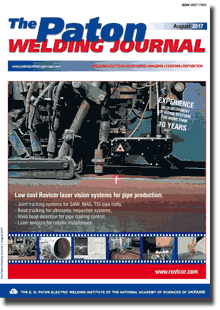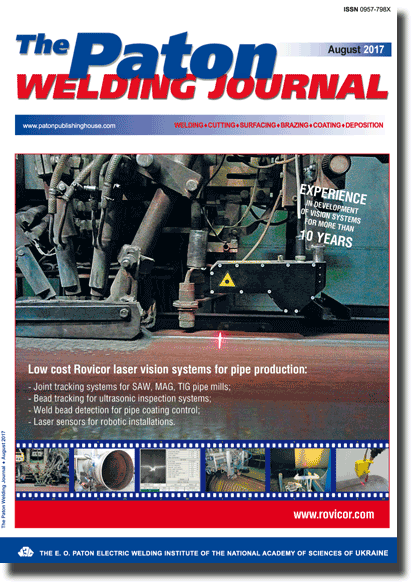| 2017 №08 (06) |
DOI of Article 10.15407/tpwj2017.08.07 |
2017 №08 (08) |

The Paton Welding Journal, 2017, #8, 46-50 pages
Equipment and technology of anticorrosion electroslag surfacing applying two strips
I.A. Ryabtsev1, A.A. Babinets1, V.N. Korzhik2, A.I. Sitko3 and Zhan Yuipeng2
1E.O. Paton Electric Welding Institute, NASU 11 Kazimir Malevich Str., 03680, Kiev, Ukraine. E-mail: office@paton.kiev.ua
2Guangdong Welding Institute (E.O. Paton Chinese-Ukrainian Institute of Welding) 510650, China, Guangzhou City, Tianhe, Changxing Road, 363
3LLC «Scientific and Production Center «PLAZER» 10-A, Filatova str., off. 2/10, Kiev, Ukraine. Е-mail: рlаzеr2010@metа.uа
Abstract
The E.O. Paton Electric Welding Institute together with the E.O. Paton Chinese-Ukrainian Institute of Welding and the SPC «PLAZER» developed the equipment and technology for anticorrosion electroslag surfacing applying strips. The effect of current, voltage and surfacing speed as well as the gap between the strips on the stability of electroslag process, geometric dimensions of deposited beads and volume of base metal in the deposited one were investigated. In the experiments the stainless strips ESAB 309LNb ESW with the cross-section of 0.5?60 mm and the flux ESAB OK 10.10 were used. The range of surfacing modes applying two strips was determined, providing a high efficiency and a stable electroslag process with a good formation of deposited metal and a minimal penetration of the base one in the ranges of 7–9 %: Is = 1400–1500 A; Us = 32–33 V; vs = 14–17 m/h; the gap between the strips is 16 mm. The mechanical properties of the metal deposited at these modes applying the strips ESAB 309LNb ESW under the flux ESAB OK 10.10 are at the level of mechanical properties of steel 309LNb. The obtained results can be used in selection or development of materials and technologies for anticorrosion surfacing of parts of power and chemical equipment. 7 Ref., 1 Table, 6 Figures.
Keywords: electroslag surfacing applying strips, surfacing technology, surfacing equipment, penetration, efficiency of surfacing
Received: 25.04.17
Published: 01.08.17
References
- Kravtsov, T.G. (1978) Electric arc surfacing using electrode strip. Moscow: Mashinostroenie.
- Ryabtsev, I.A. (2005) High-efficiency wide-layer surfacing using electrode wires and strips (Review). The Paton Welding J., 6, 31–35.
- Ivanov, V.P., Ivashchenko, V.Yu. (2011) Influence of hardfacing technology and heat treatment on structure and properties of metal deposited on carbon steel by LN-02Kh25N22AG4M2 strip electrode. Ibid., 8, 7–9.
- Ryabtsev, I.A., Senchenkov, I.K., Turyk, E.V. (2015) Materials, technologies, mathematical modeling. Glivize: Silesia Polytechnical Institute.
- Frumin, I.I., Kalensky, V.K., Panchishin, Yu.A. et al. (1977) Development of process and investigation of some technological specifics of strip electroslag surfacing. In: Theoretical and technological principles of surfacing. New processes of mechanized surfacing. Kiev: PWI, 83–88
- Kalensky, V.K., Panchishin, Yu.A., Shekhteri, S.Ya. et al. (1980) Application of electroslag surfacing using sintered strips for manufacture of two-layer sheet billets. In: Theoretical and technological principles of surfacing. Properties and tests of deposited metal. Kiev: PWI, 89–92.
- Ignatov, V.A., Murzin, V.V., Rokhlin, E.A. et al. (1980) Examination of process of electroslag anticorrosion surfacing using two strip electrodes. In: Ibid.. Kiev: PWI, 101–106.
Suggested Citation
I.A. Ryabtsev, A.A. Babinets, V.N. Korzhik, A.I. Sitko and Zhan Yuipeng (2017) Equipment and technology of anticorrosion electroslag surfacing applying two strips. The Paton Welding J., 08, 46-50.The cost of subscription/purchase order journals or individual articles
| Journal/Currency | Annual Set | 1 issue printed |
1 issue |
one article |
| TPWJ/USD | 384 $ | 32 $ | 26 $ | 13 $ |
| TPWJ/EUR | 348 € | 29 € | 24 € | 12 € |
| TPWJ/UAH | 7200 UAH | 600 UAH | 600 UAH | 280 UAH |
| AS/UAH | 1800 UAH | 300 UAH | 300 UAH | 150 UAH |
| AS/USD | 192 $ | 32 $ | 26 $ | 13 $ |
| AS/EUR | 180 € | 30 € | 25 € | 12 € |
| SEM/UAH | 1200 UAH | 300 UAH | 300 UAH | 150 UAH |
| SEM/USD | 128 $ | 32 $ | 26 $ | 13 $ |
| SEM/EUR | 120 € | 30 € | 25 € | 12 € |
| TDNK/UAH | 1200 UAH | 300 UAH | 300 UAH | 150 UAH |
| TDNK/USD | 128 $ | 32 $ | 26 $ | 13 $ |
| TDNK/EUR | 120 € | 30 € | 25 € | 15 € |
AS = «Automatic Welding» - 6 issues per year;
TPWJ = «PATON WELDING JOURNAL» - 12 issues per year;
SEM = «Electrometallurgy Today» - 4 issues per year;
TDNK = «Technical Diagnostics and Non-Destructive Testing» - 4 issues per year.


